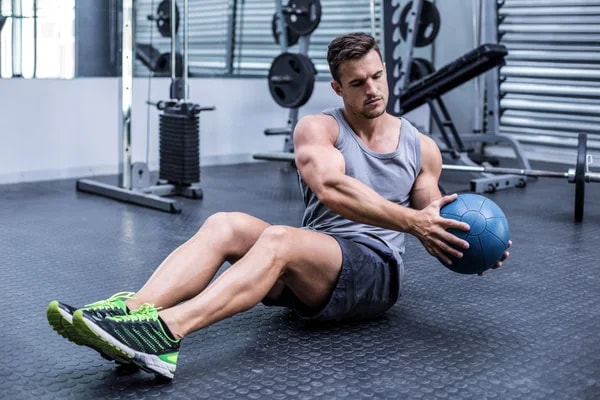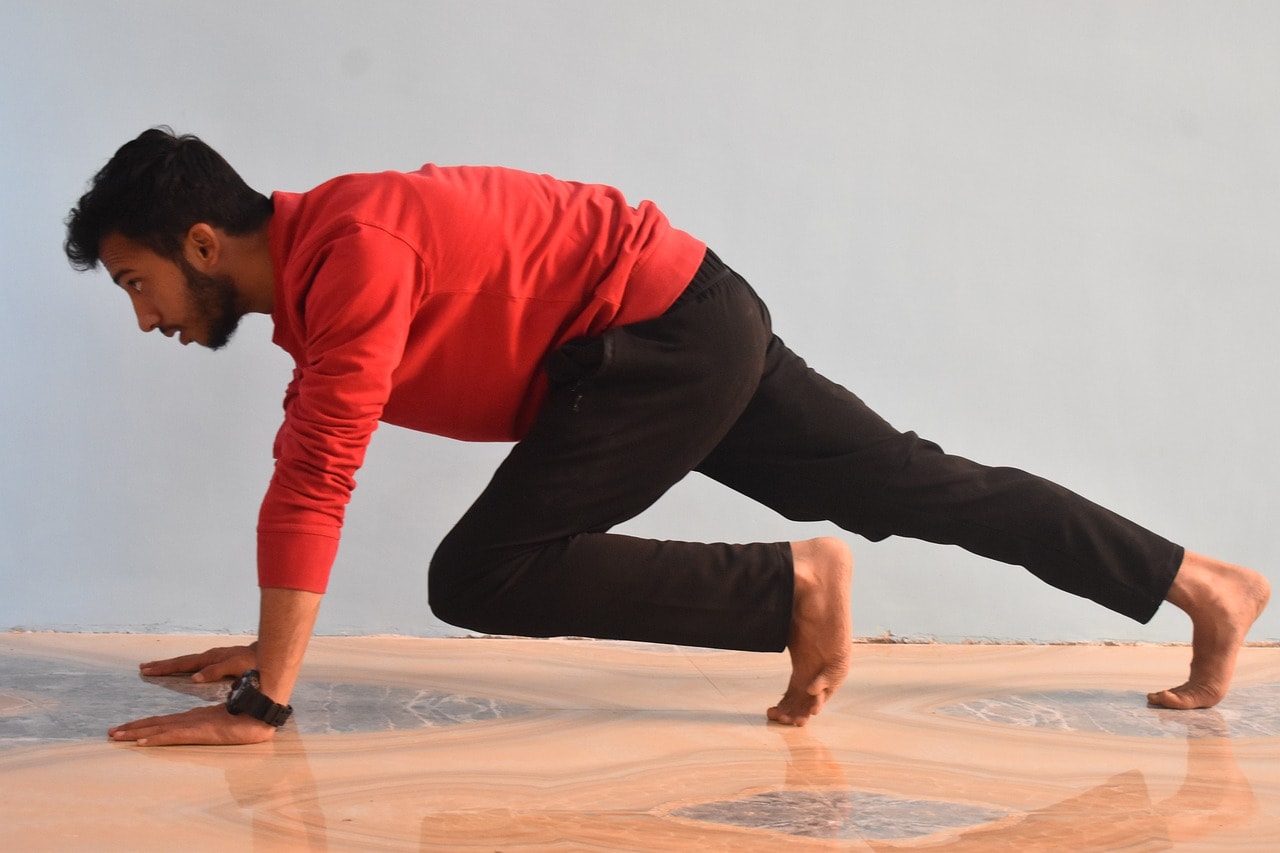Building Core Stability Through Strength Training
Getting fit and strong all starts with core stability and a solid core. The core muscles (abs, back, pelvic floor) are the foundation for stability and strength. If you haven’t tried adding core exercises to your routine, prepare to have your mind blown at how amazing these simple exercises can be.
Why Core Strength Is So Great

While you may only be considering the six-pack abs you can get from building a strong core, that is the least of its benefits. A strong core is the foundation of strength. It helps your posture, helps avoid injuries, and by improving the stability and power of your upper body, it helps you perform better in everyday activities. It supports your spine and helps you move freely and strongly without pain.
Core stability exercises are essential when you are lifting weights doing squats, deadlifts, bench presses, etc., as a strong core keeps form proper and allows you to lift heavier weight. Without a strong core, everything else declines. Focus on the core and you’ll see clear improvements in your workouts.
I know that when I started lifting, I was quick to overlook core exercises, thinking just because I wouldn’t see the abs getting built right away, that they were useless. I was proven to be completely wrong and am glad to say I changed my workout routine to build that crucial core strength.
Perks of Core Exercises

Here are just a few of the benefits of core exercises:
- Better Posture: A strong core keeps your spine aligned and will help you sit and stand better. Better daily posture means less back pain, so don’t overlook this one.
- Boosted Athletic Performance: Core strength creates power and efficiency in movement, helping you in all physical activity, but especially sports.
- Injury Prevention: Core exercises will stabilize your entire body, and help prevent injuries, especially in the lower back.
- Functional Movement: Everyday activities like lifting things, bending over, and twisting in any direction, will be much easier and safer with a strong core.
- Improved Balance and Stability: Core exercises help improve your balance, making you more coordinated and less prone to clumsiness (I relate to this one).
To reap the benefits of core exercises and enhance core stability, you must do the right exercises, and do them with proper form. Otherwise, you’ll miss out on these gains.
Understanding Core Muscles

The core muscles are the powerhouse of your body, providing the stability and support needed for almost every movement you make. These muscles include the abdominal muscles, back muscles, and the muscles around the pelvis. Together, they form a strong foundation that supports your spine and helps you move efficiently.
The core muscles can be divided into several key groups:
- Rectus Abdominis: This is the muscle that runs down the front of your abdomen and is often referred to as the “six-pack” muscle. It helps with flexing the spine and stabilizing the pelvis.
- Obliques: These muscles are located on the sides of your abdomen. There are two types: internal and external obliques. They are crucial for rotational movements and help stabilize the core.
- Transverse Abdominis: This is the deepest abdominal muscle, wrapping around your spine and pelvis like a corset. It plays a vital role in maintaining core stability and supporting your lower back.
Understanding these muscle groups and how they work together is essential for effective core training. By targeting each of these areas, you can build a strong core that enhances your overall strength and stability.
How to Engage Your Core
Engaging your core muscles is the key to maximizing the benefits of your core exercises. Think of it as bracing your body for impact. Here’s a simple way to practice engaging your core:
- Starting Position: Lie on your back with your knees bent and feet flat on the floor.
- Press Your Back: Press your lower back into the floor, ensuring there is no gap between your back and the ground.
- Hand Test: Try to slide your hand under your lower back. If you can’t, you’re doing it right.
- Hold and Release: Hold this position for 6-10 seconds, then relax. Repeat this 3-4 times.
Another effective technique is to draw your belly button towards your spine. This action activates the transverse abdominis muscle, which is crucial for core stability. Practice this by standing or sitting upright, pulling your belly button in, and holding for a few seconds before releasing.
By consistently engaging your core during exercises, you’ll ensure that you’re targeting the right muscles and getting the most out of your workouts.
The 5 Best Core Exercises for Stability

Now, it is time for us to get into the best core stability exercises you can do today to improve that core strength. Here’s what we will go over:
- Planks (& Variations): Planks are the go-to core exercise for a reason. There are many variations of planks that are great for building core endurance.
- Dead Bug: One of my favorite core exercises, dead bugs are amazing for working your abs and improving coordination.
- Russian Twists: A versatile exercise that is probably the best at targeting your obliques and improving rotational strength.
- Leg Raises: Loved by many of the world’s strongest men, bodybuilders, leg raises are phenomenal at building the lower abs and strengthening the hip flexors.
- Mountain Climbers: Possibly the best core exercise that works as a full-body workout and gets that heart rate up.
Now we will get into each of these exercises one by one, and discuss how you can optimize these exercises in your routine to build core strength.
Planks and Their Many Variations
Core stability exercises, such as plank exercises, are one of the best and most well-known exercises for building core strength. They work multiple muscle groups, including your abs, back, and spine. The fun part about planks is how many different variations there are that can target different muscles, and keep things interesting.
Front Plank

The basic front plank, the go-to of core exercises. You cannot go wrong with this ridiculously simple exercise that I am sure you have seen before.
How to do a Front Plank:
- Lie down on the floor, face down.
- Place your forearms on the ground (or hands for a high plank), and keep your elbows under your shoulders.
- Lift up your body, balancing on your forearms and toes.
- Keep your body in a straight line and squeeze your core to help you balance.
- Hold as long as you can!
Again, so simple. Yet, after just 30 seconds, you might feel the burn… Front planks workout your abs, back, and even your shoulders, arms, and legs. Really, your whole body! This exercise is excellent for improving core stability.
Side Plank

The side plank focuses in on your obliques, the muscles on the sides of your core. If you are looking at some “love handles” and want to get rid of them (I fall into this category 7 days a week), these are perfect for you.
How to do a Side Plank:
- Lie on your side, forearm on the ground, elbow under your shoulder.
- Place one foot on top of the other (or one in front of the other) for balance.
- Lift your body, balancing on your forearm and the side of your foot.
- Keep your body straight, and squeeze your core.
- Hold for as long as possible, then switch sides.
The side plank also works your shoulders, hips, and legs, enhancing core stability.
Reverse Plank

The reverse plank is a bit trickier, taking a bit more focus and flexibility.
How to do a Reverse Plank:
- Sit on the ground with your legs extended.
- Place your hands behind you, with your fingers pointing toward your feet.
- Lift your hips, balancing on your hands and heels.
- Keep your body straight, and keep your core tight.
- Hold as long as you can!
The reverse planks works your back, glutes, and hamstrings, plus will give your shoulders and arms a slight workout.
Adding different kinds of plank variations to your routine will help build your core strength and stability. Always try to hold these positions for as long as you can, aiming to beat your last time. Keep your core flexed and tight during the exercises for the best results.
These are great exercises to do at the end of a lift, and they’ll only take a few extra minutes of your time. For more on how to best incorporate planks into your strength training, check out our beginner’s guide.
Dead Bug

The Dead Bug exercise is an awesome way to build core stability and strength without being in the gym 24/7. It is quite simple but very effective for people of all fitness levels.
How to Do the Dead Bug Exercise:
- Lie on your back and reach your arms straight up towards the sky.
- Bend your knees and lift your legs so that your thighs are upright and your shins are parallel to the ground. Form a 90 degree angle with your knees.
- Pull your belly button towards your spine to keep your lower back stuck to the ground.
- Lower your right arm behind you while straightening your left leg outwards. Keep your back flat.
- Bring your right arm and left leg back to the starting position.
- Now, alternate sides so that your left arm is lowered, and your right leg is straight.
- Continue to alternate sides for as many reps as you can to improve core stability.
Benefits of the Dead Bug

The Dead Bug exercise isn’t just about looks; it has some real benefits for core stability:
- Core Power: This exercise targets the deep core muscles like the transverse abdominis and multifidus. These muscles are very important for a strong and stable spine.
- Balance and Coordination: This exercise challenges balance and coordination since you have to use limbs on both sides of your body simultaneously.
- Better Posture: This will help you build a strong spine and good posture, allowing you to stand tall and free of back pain.
- Injury Prevention: This will help prevent injuries that come from twisting, bending and lifting, all very common throughout a normal day.
To get the most out of the Dead Bug, keep your form tight and your core engaged. Once again, try to hold it for as long as you can, and try to improve on that time each workout in order to see the best gains possible.
Russian Twists

Russian twists are my personal favorite core exercise for improving core stability and strengthening the obliques. They are fun and help with those twisting motions which builds stability in the core.
How to Do Russian Twists
- Sit on the floor with your knees bent and feet flat.
- Lean back a bit, keeping your back straight and core tight.
- Hold your hands together in front of your chest.
- Lift your feet just slightly off the ground, balancing on your butt.
- Twist your torso to the right, bringing your hands toward your hip.
- Return to the center and twist to the other side.
- Keep alternating sides in a smooth, controlled way.
These are amazing to do with dumbbells or medicine balls in your hand, adding an extra challenge and allowing you to really feel a burn in your core.
Make sure to keep your back straight, your core engaged, and do not slouch. Use your abs to twist, not momentum, to enhance core stability.
How Russian Twists Work the Core Muscles
Russian twists hit the obliques hard but they also work the rectus abdominis and transverse abdominis, enhancing core stability. The rotational strength and control gained from these is unmatched.
Don’t swing your body, but rather fully twist to your side by using the core. If you do this right, with your core muscles flexed, you will feel it.
If it is difficult at first, just start without weights, and slowly add light weights (5-15 lbs) as you get better.
Leg Raises

Leg raises are an amazing core exercise that significantly improve core stability and really pack on the muscle. You can do either straight leg raises or bent leg raises, as each hit different parts of your core.
Leg raises also engage the hip flexors, which is key to building overall core strength and preventing muscle imbalances.
I recently heard Mr. Olympia Chris Bumstead say that if he could only do 10 exercises for the rest of his life, leg raises would be one of them. If that does not tell you how amazing these are, I don’t know what will.
Straight Leg Raises

Straight leg raises focus on your lower abs, hip flexors, and lower back.
How to:
- Lie on your back with your legs fully stretched out.
- Place your hands flat on the floor, palms down.
- Keep your legs straight and slowly lift them off the ground as high as you can comfortably go.
- Hold that position for a few seconds, keeping that core tight.
- Slowly lower your legs back down but stop right before they hit the ground.
- Repeat as many times as you can.
Aim for 3 sets of 8-12 reps of straight leg raises, or as many reps as you can! Remember to control your breathing, avoid arching your back or swinging your legs around using momentum to maintain core stability.
Hanging Leg Raises

Hanging leg raises have become my favorite core exercise, as they really build the lower abs and obliques. These are a bit trickier and most likely better left for the slightly more advanced fitness enthusiast. So be careful with these.
How to:
- Grab a pull-up bar and hang, fully extended.
- Keep your legs straight and slowly lift them to be parallel with the ground.
- While flexing your core, slowly let your legs back down.
- Repeat!
Make sure not to swing doing these. If you do them slowly, you will feel that burn, which is a good thing for core stability.
Bent Leg Raises

Bent leg raises focus more on your upper abs and hip flexors.
How to:
- Lie on your back with your legs bent and feet flat on the ground.
- Place your hands flat on the floor.
- Keeping your feet on the ground, lift your knees towards your chest, bringing them as close as possible.
- Hold the position for a few seconds, flexing the core.
- Slowly lower your legs back down.
- Repeat!
Do 8-12 reps of bent leg raises, aiming for 2-3 sets. Keep the motion controlled and avoid using momentum to lift your legs.
Leg raises can be tough, especially if you’re just starting out. Begin with an easy range of motion and slowly progress as you go.
Adding leg raises to your workout can greatly improve your core stability and overall strength. I love adding them at the end of every lift, along with my Russian twists!
Mountain Climbers

Mountain climbers are a phenomenal core exercise that enhances core stability, hits multiple muscle groups, and gets your heart rate going. These are great for athletes as well. I remember because my football coach used to absolutely kill me with these.
How to Do Mountain Climbers
- Get into a high plank position with your hands palm down on the ground, and shoulder-width apart.
- Keep your body straight and flex the core.
- Lift your right foot off the ground and bring your right knee towards your chest, try to touch your right knee to your right elbow.
- Quickly switch legs, extending your right leg back to the starting position while bringing your left knee towards your left elbow.
- Keep alternating legs, like you’re running in place.
- Keep a good pace and focus on good form throughout the exercise.
Good form is key to getting the most out of mountain climbers. Keep your alignment proper and flex the core. Don’t let your hips sag or lift too high, or they won’t be as effective. This exercise is excellent for improving core stability.
Core Engagement During Mountain Climbers

Mountain climbers mainly target the rectus abdominis, which is that “six-pack” look you are dreaming of. They also work the obliques, the transverse abdominis, and the lower back muscles. The non-stop movement and need for core stability make all these muscles work together.
To get the most out of mountain climbers, focus on:
- Keep a strong and stable plank position.
- Keep your core flexed and tight.
- Stabilize your pelvis to avoid a lot of hip movement.
- Bring your knees towards your elbows, not just your chest.
- Breathe deeply and rhythmically.
Start at a pace that fits your fitness level and ramp up the intensity as you get more comfortable.
How Often to Do Core Exercises
Building strong core muscles requires consistency and dedication. To see significant improvements in core strength and stability, aim to incorporate core exercises into your routine 2-3 times per week. This frequency allows your muscles to recover while still providing enough stimulus for growth and development.
Here are some tips for effective core training:
- Mix It Up: Variety is key. Incorporate different exercises that target various muscle groups within the core. This not only keeps your workouts interesting but also ensures balanced muscle development.
- Listen to Your Body: Pay attention to how your body feels. If you’re experiencing fatigue or discomfort, take a rest day. Overtraining can lead to injury and hinder your progress.
- Progress Gradually: Start with shorter sessions and gradually increase the duration and intensity as you build strength and endurance. This approach helps prevent burnout and keeps you motivated.
By making core exercises a regular part of your fitness routine, you’ll develop strong core muscles that support your overall strength and stability. Remember, consistency is key, so stick with it and enjoy the benefits of a strong core.
Conclusion

Well, there it is! Now you have all of the tools needed to build a strong and stable core. Try including some of these tips and tricks into your workout routine consistently over a few weeks and months, and see what happens! I bet you will never go back.
Once you have a strong core, you won’t be able to comprehend how you lifted with weak core muscles. Your lifts will go up, everyday activities will become easier, and you will even start to notice that belly is looking quite a bit better.. Not so bad, right?
Now, get off your phone or laptop, and hit that core. You got this!
Sources
- Oliva-Lozano JM, Muyor JM. Core Muscle Activity During Physical Fitness Exercises: A Systematic Review. Int J Environ Res Public Health. 2020 Jun 16;17(12):4306. doi: 10.3390/ijerph17124306. PMID: 32560185; PMCID: PMC7345922.
- Dong K, Yu T, Chun B. Effects of Core Training on Sport-Specific Performance of Athletes: A Meta-Analysis of Randomized Controlled Trials. Behav Sci (Basel). 2023 Feb 9;13(2):148. doi: 10.3390/bs13020148. PMID: 36829378; PMCID: PMC9952339.
- Smrcina Z, Woelfel S, Burcal C. A Systematic Review of the Effectiveness of Core Stability Exercises in Patients with Non-Specific Low Back Pain. Int J Sports Phys Ther. 2022 Aug 1;17(5):766-774. doi: 10.26603/001c.37251. PMID: 35949382; PMCID: PMC9340836.
- Hsu SL, Oda H, Shirahata S, Watanabe M, Sasaki M. Effects of core strength training on core stability. J Phys Ther Sci. 2018 Aug;30(8):1014-1018. doi: 10.1589/jpts.30.1014. Epub 2018 Jul 24. PMID: 30154592; PMCID: PMC6110226.







